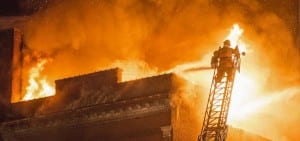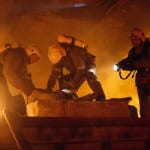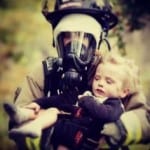 During a recent Flawed Situational awareness program, I engaged the class in a discussion of what the actions of the first-in officer should be once the decision is made to be offensive/interior. The choices were:
During a recent Flawed Situational awareness program, I engaged the class in a discussion of what the actions of the first-in officer should be once the decision is made to be offensive/interior. The choices were:
a.) Make entry with the crew;
b.) Establish a fixed command position outside and send the crew in without the officer, and c.) Hold the entire crew outside and wait for more help.
c.) Hold the entire crew outside and wait for more help.
Clearly, each decision contains an element of risk. The discussion was so good I thought it would be worth writing about. So, what should the actions of the first-in officer be? Let’s explore this decision.
What is a decision?
[clickandtweet handle=”richgasaway” hashtag=”samatters” related=”samatters” layout=”” position=””]A decision is a choice among alternatives[/clickandtweet] , hopefully, derived from some level of thoughtful consideration to the consequences of the decision prior to engagement. If you are willing to accept that definition, then we can clearly establish that there is no clear cut, one answer fits all occasions, answer. So, it depends. But depends on what?
Stating the Obvious

The one thing I was able to accomplish in my discussion with this class was the fact that any officer that goes hands-on, task-level, on the interior of the structure, cannot maintain big-picture situational awareness. They can have SA about the area they are working in (for so much as they can see, hear and feel). But they simply will not be in a position to see the big picture changing conditions. Thus, when the first-in company officer chooses to go hands-on, interior, they forfeit the big picture view of the incident.
Relief is on the way
Typically, when the first-in officer makes the decision to go hands on, task-level, on the interior, it is with the knowledge they will be relieved of their command duties upon the arrival of another officer. In some jurisdictions, the second in officer will assume command, regardless of rank or riding position. In other jurisdictions, the second in officer will also perform task-level duties with their crew and the fixed, exterior command isn’t established until a chief-level officer arrives on the scene.
 [clickandtweet handle=”richgasaway” hashtag=”samatters” related=”samatters” layout=”” position=””]The risk to the first-in crew comes from two factors.[/clickandtweet]
[clickandtweet handle=”richgasaway” hashtag=”samatters” related=”samatters” layout=”” position=””]The risk to the first-in crew comes from two factors.[/clickandtweet]
First, it’s the speed at which conditions are changing. If the rate of heat, smoke and fire growth is relatively slow (usually indicating a small fire or a fire lacking fuel) then the officer can buy more time interior without the benefit of a fixed exterior commander. If the rate of heat, smoke and fire growth is fast, the officer is taking quite a risk. To engage interior is to forgo being in a position to see the big picture.
The Second factor is the length of time the officer will have to operate as command from the interior position. If the officer who will be assuming command is just a minute or two away, then the risk to the interior crew may be limited. However, if for whatever reason, the arrival of the officer who will assume command is going to be elongated – say ten minutes – then the risk to the interior crew will likely be elevated.
The worst of both worlds
[clickandtweet handle=”richgasaway” hashtag=”samatters” related=”samatters” layout=”” position=””]Consider the possibility of a fire with rapidly advancing heat, smoke and fire conditions[/clickandtweet]
, coupled with a delay in the arrival of the officer who will assume the fixed, exterior command position. The risk to the interior crew can be overrun by changing conditions without them knowing the risk has vastly increased.
Team Situational Awareness
In a recent article, I addressed the need to conduct a situational awareness assessment of your crew. Instead of covering that ground again, I will simply refer you to the search box where you can type the term “Team Situational Awareness” and read that article.
The crew quantity and crew quality are an important factor in the decision of what the officer should do. If the crew size is adequate and the experience level of the crew is strong, the officer may be able to send the crew in while maintaining a fixed position on the exterior.
If, however, the crew size is not adequate or the crew experience is limited, the best place for the officer might be inside with the crew, supervising and assisting with the performance of the tasks. In departments where personnel responds from home, the crew quantity and crew quality are unpredictable. The important thing is for the officer to avoid treating every crew as if they are equal in knowledge, skills, and abilities, but this is simply not the case.
One option the officer has when dealt the cards of an understaffed or inexperienced crew is to establish a fixed command position on the exterior and have the crew engage in an aggressive, exterior firefight until more help arrives. Under certain circumstances, this may be the safest action for the company officer.
Urgency
 Of course, urgency is always a consideration. As it is often said, and accurately so, putting the fire out resolves most of the problems on a fireground. It is rare that the conditions of a fire will self-improve without our intervention. And for so much as our need for action is time-compressed, we must be diligent in making our decisions or we may quickly find ourselves adding to the problems on the fireground instead of resolving them.
Of course, urgency is always a consideration. As it is often said, and accurately so, putting the fire out resolves most of the problems on a fireground. It is rare that the conditions of a fire will self-improve without our intervention. And for so much as our need for action is time-compressed, we must be diligent in making our decisions or we may quickly find ourselves adding to the problems on the fireground instead of resolving them.
[clickandtweet handle=”richgasaway” hashtag=”samatters” related=”samatters” layout=”” position=””]The search and rescue of victims is always a top priority for first-arriving companies. [/clickandtweet]
However, not all victims are savable. That is simply a fact. Sometimes the circumstances are not conducive for a rescue and the window of opportunity to save someone have closed prior to our arrival or the window of opportunity is closing so fast that we will not be able to change the outcome.
Chief Gasaway’s Advice
 A proper size-up can go a long way toward helping the officer make the decision of whether to go interior or remain outside. Factors include:
A proper size-up can go a long way toward helping the officer make the decision of whether to go interior or remain outside. Factors include:
• Conditions (heat, smoke, fire);
• Building (size, construction & decomposition);
• Speed (how are conditions changing and the building decomposing);
• Victim Survivability (Are there survivable spaces and can you get to them in time);
• Resource availability (crew quantity/quality, equipment, and water);
• Relief (How long will you have to operate as interior command until relieved?).
If you find yourself inheriting an outcome you cannot change, the best thing you can do is keep yourself, and your crew, out of the way of the outcome you cannot change. The officer who chooses to get in the way of an outcome he or she cannot change is creating risk.
Action Items
 1. Discuss the conditions and circumstances when the first-in officer should establish command and engage in task-level, interior operations.
1. Discuss the conditions and circumstances when the first-in officer should establish command and engage in task-level, interior operations.
2. Discuss the conditions and circumstances when the first-in officer should establish a fixed command position on the exterior and send his or her crew interior.
3. Discuss the conditions and circumstances when the first-in officers should establish a fixed command position on the exterior and have the crew perform aggressive/exterior operations until more help arrives.
_____________________________________________________
If you are interested in taking your understanding of situational awareness and high-risk decision making to a higher level, check out the Situational Awareness Matters Online Academy.
CLICK HERE for details, enrollment options and pricing.
__________________________________
Share your comments on this article in the “Leave a Reply” box below. If you want to send me incident pictures, videos or have an idea you’d like me to research and write about, contact me. I really enjoy getting feedback and supportive messages from fellow first responders. It gives me the energy to work harder for you.
Thanks,

Email: Support@RichGasaway.com
Phone: 612-548-4424
Facebook Fan Page: www.facebook.com/SAMatters
Twitter: @SAMatters
LinkedIn: Rich Gasaway
YouTube: SAMattersTV
iTunes: SAMatters Radio

